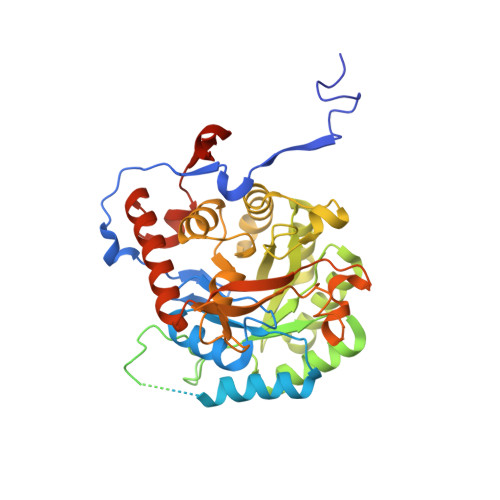Deciphering the allosteric regulation of mycobacterial inosine-5'-monophosphate dehydrogenase.
Bulvas, O., Knejzlik, Z., Sys, J., Filimonenko, A., Cizkova, M., Clarova, K., Rejman, D., Kouba, T., Pichova, I.(2024) Nat Commun 15: 6673-6673
- PubMed: 39107302
- DOI: https://doi.org/10.1038/s41467-024-50933-6
- Primary Citation of Related Structures:
8PW3, 8Q65, 8QQP, 8QQQ, 8QQR, 8QQT, 8QQV, 8QQW, 8QQX - PubMed Abstract:
Allosteric regulation of inosine 5'-monophosphate dehydrogenase (IMPDH), an essential enzyme of purine metabolism, contributes to the homeostasis of adenine and guanine nucleotides. However, the precise molecular mechanism of IMPDH regulation in bacteria remains unclear. Using biochemical and cryo-EM approaches, we reveal the intricate molecular mechanism of the IMPDH allosteric regulation in mycobacteria. The enzyme is inhibited by both GTP and (p)ppGpp, which bind to the regulatory CBS domains and, via interactions with basic residues in hinge regions, lock the catalytic core domains in a compressed conformation. This results in occlusion of inosine monophosphate (IMP) substrate binding to the active site and, ultimately, inhibition of the enzyme. The GTP and (p)ppGpp allosteric effectors bind to their dedicated sites but stabilize the compressed octamer by a common mechanism. Inhibition is relieved by the competitive displacement of GTP or (p)ppGpp by ATP allowing IMP-induced enzyme expansion. The structural knowledge and mechanistic understanding presented here open up new possibilities for the development of allosteric inhibitors with antibacterial potential.
Organizational Affiliation:
Institute of Organic Chemistry and Biochemistry of the Czech Academy of Sciences, Prague, Czech Republic.















